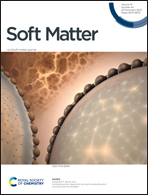The effect of polymer end-group on the formation of styrene – maleic acid lipid particles (SMALPs)†
Abstract
A series of block copolymers comprising styrene and maleic acid (SMA) has been prepared using RAFT polymerisation. RAFT often results in a large hydrophobic alkylthiocarbonylthio end group and this work examines its effect on the solution behaviour of the copolymers. SMA variants with, and without, this end group were synthesised and their behaviour compared with a commercially-available random copolymer of similar molecular weight. Dynamic light scattering and surface tension measurements found the RAFT-copolymers preferentially self-assembled into higher-order aggregates in aqueous solution. Small angle neutron scattering using deuterated styrene varients add support to the accepted model that these agreggates comprise a solvent-protected styrenic core with an acid-rich shell. Replacing the hydrophobic RAFT end group with a more hydrophilic nitrile caused differences in the resulting surface activity, attributed to the ability of the adjoining styrene homoblock to drive aggregation. Each of the copolymers formed SMALP nanodiscs with DMPC lipids, which were found to encapsulate a model membrane protein, gramicidin. However, end group variation affected solubilisition of DPPC, a lipid with a higher phase transition temperature. When using RAFT-copolymers terminated with a hydrophobic group, swelling of the bilayer and greater penetration of the homoblock into the nanodisc core occurred with increasing homoblock length. Conversely, commercial and nitrile-terminated RAFT-copolymers produced nanodisc sizes that stayed constant, instead indicating interaction at the edge of the lipid patch. The results highlight how even minor changes to the copolymer can modify the amphiphilic balance between regions, knowledge useful towards optimising copolymer structure to enhance and control nanodisc formation.

- This article is part of the themed collection: Celebrating the scientific accomplishments of RSC Fellows


 Please wait while we load your content...
Please wait while we load your content...